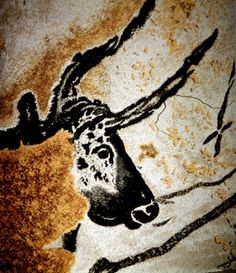The marvelous cave paintings of Europe represent many of the earliest examples of art that we have and the question has always been "how could the first ones be among the greatest and most beautiful, where was the learning curve?"
Well, it may be that some of the examples of the learning curve have been right before our eyes all along. The earliest dated cave art in Europe is found in Chauvet Cave, in France. In Chauvet Cave "more than 80 radiocarbon dates had been obtained by 2011, with samples taken from torch marks and from the paintings themselves, as well as from animal bones and charcoal found on the cave floor. The radiocarbon dates from these samples show that there were two periods of creation in Chauvet: 35,000 years ago and 30,000 years ago. One of the surprises was that many of the paintings were modified repeatedly over thousands of years, possibly explaining the confusion about finer paintings that seemed to date earlier then cruder ones." (Wikipedia) Note that it says that paintings were modified repeatedly over thousands of years. If we read that to mean corrected and/or improved we have a pretty good explanation.
In Lascaux Cave, in France, the learning curve might also actually be visible for our analysis. One mystery in Lascaux is the creature that has been called "the unicorn." This is a large, bovine looking animal with two long straight horns projecting forward and up from its head. Its body and head are relatively crude. I submit that this may, in fact, be an aurochs, one of the earliest attempts, and one poorly done at that. Reconstructions of the aurochs show that the horns start out projecting from the skull to the sides and then arcing forward with the tips curving upward. If I am right the "unicorn" is a first attempt to depict an aurochs with no appreciation for the artistic techniques of perspective, the double curves of the horns were just too difficult for this painter.
Other examples in Lascaux show aurochs horns shaped like a lyre, a much more sophisticated, and therefore, I assume, later portrayal.
The earlier images from Chauvet Cave, although in many respects more sophisticated in representations of shape, coloration, and coat shading, are, to my mind, less successful in portraying the horns of the aurochs. One famous panel shows the horns projecting forward with a double curve but in a single plane. This shows that the horns were curved, but it is completely inadequate in portraying their actual shape and orientation.
Now, I am not trying to imply that artists from one cave learned from the artists of another cave. I do not believe that they knew of the other artists or their works, but it does seem likely that they learned from the artists who had gone before them in their own communities. I suspect that when we can get direct dating from the paints we will learn the order of the production of the images in each cave, but until that day we have to look for clues in the images themselves, and I submit that one clue can be the portrayal of details such as the aurochs horns examined here.
NOTE: Some images in this posting were retrieved from the internet with a search for public domain photographs. If any of these images are not intended to be public domain, I apologize, and will happily provide the picture credits if the owner will contact me with them. For further information on these reports you should read the original reports at the sites listed below.
REFERENCES:
https://en.wikipedia.org/wiki/Cave_painting











No comments:
Post a Comment